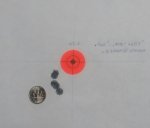Howdy! After recently switching powders from IMR 4064 to IMR 4166, I performed an OCW test using my Remington 700P. The test revealed that from 42.9 to 43.5 gave the closest similar POI; however, at 43.5, the bolt was getting hard to open as IMR claims 43.1 is the maximum. I chose the middle of those three at 43.2. I then tried that load at 200 yards. The group sizes went from .540 MOA down to .313 MOA being the best. My problem lies with vertical stringing, its causes,and trying to eliminate it. There are no signs of my barrel touching the stock. The bolt lugs both appear to be contacting the receiver equally according to wear marks. I did notice that at lower charge weights there was no vertical stringing. Is it possible that it is being caused by this particular powder? The 43.2 charge puts me at 2607 fps avg. If I drop the charge weight to 41.7, I'm at around 2500, but with no vertical stringing. What's your guys opinions on this. Thanks


